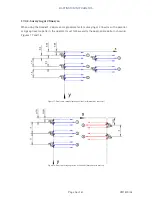
BARTINGTON INSTRUMENTS
Page 39 of 61 OM1800/26
Note:
For a Grad601-2 dual sensor gradiometer, use a trapeze with 1m between the two
ropes. Mark the ropes defining the start and end of each traverse such that placing the
centre marks of the trapeze over the marks on the edge ropes guides the operator along
the traverse with one sensor over each of the trapeze lines.
Figure 21 shows the rope marking, trapeze position and sensor position for obtaining data at 1, 2
or 4 lines/m with a dual sensor gradiometer.
Use this diagram to prepare different ropes for each case.
Note:
Walking between ropes as shown requires two operators to move the ropes, but
avoids the possibility of the operator tripping as they carry the sensors along a line on the
ground.
Note:
With practice, the trapeze guide may be abandoned and the operation simplified by
using canes to walk to at each end of the traverse as described later.
18. Survey Operation (Grid Mode)
When
Start survey
is selected from the menu, the data logger indicates the Grid number and waits
for the operator to confirm this by pressing the
ENTER
key.
The display will then show that the instrument is ready to start the first traverse.
Note:
To ensure good alignment of the data, the operator should:
•
stand away from the line marking the start of the traverse
•
press and hold the external green push button or
Enter
key
•
start walking, reaching the normal pace before crossing the start line
•
release the green button or
Enter
key exactly as the sensors reach the start line.
If
Audio on
has been selected, the data logger will bleep as the operator releases the key,
and then at 1m intervals along the traverse. The operator should regulate the pace so that
the bleeps coincide with the sensor passing the metre markers. A double bleep will sound
as the operator reaches the end of the traverse.
Note:
It is important to pass the start and end of the traverse at the normal walking pace if
staggering of the data is to be avoided.
Note:
Precision in releasing the green push button or
Enter
key is very important. For
example, with a pace of 1.8m/s and 4 readings per metre, a delay of only 140ms will cause
an apparent shift in the data by 0.25m. When this is repeated in the other direction for
zigzag traverses, a total stagger of 0.5m will be seen.






























